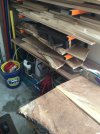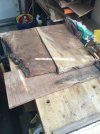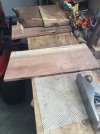I know there are a number of videos, books, workshops etc. to help teach flattening a board.
I just listened to this one by Rex Krueger and thought it was worth sharing:
I find his examples and methods helpful - he also references Richard Maguire and Joshua Klein
(I know he uses a "rag in an oil can" so that is a nod to Paul Sellers as well...
I just listened to this one by Rex Krueger and thought it was worth sharing:
(I know he uses a "rag in an oil can" so that is a nod to Paul Sellers as well...



